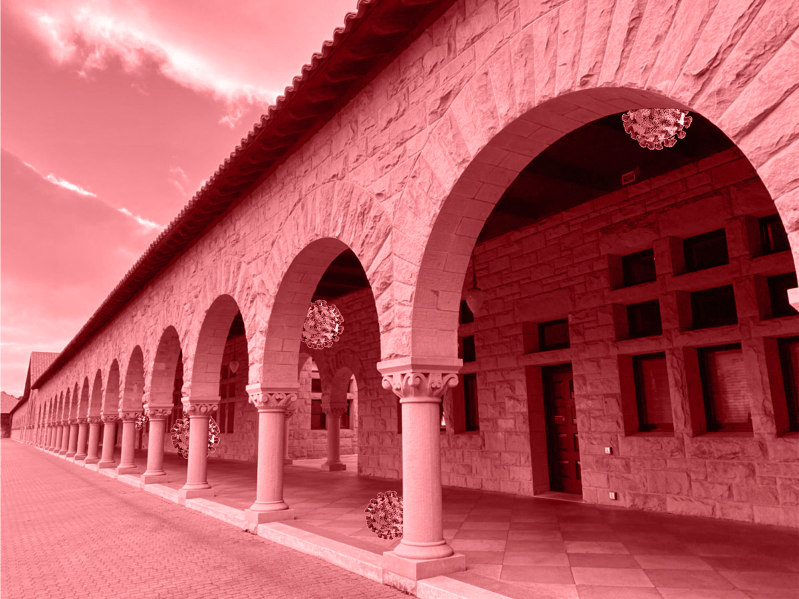After Stanford called off its plans to bring frosh and sophomores onto campus for winter quarter, many University researchers and professors agreed that it was the safest decision from a public-health standpoint.
The University announced the change in plans last Friday, a day after reporting that 43 students tested positive for COVID-19 on campus. As of Monday’s update on Stanford’s COVID-19 dashboard, 11 additional students have tested positive, bringing the total number of student cases last week to 54.
Medicine professor Dean Winslow said Stanford’s interim winter plans were “not unreasonable.” But he and clinical assistant professor of emergency medicine Shashank Ravi agree that the on-campus cases, taken in the context of surges across Santa Clara County (SCC) and the Bay Area, were reason enough for Stanford to cancel plans.
When announcing the cancellation, the University cited rises in positivity rates and the impact of lengthening public-health restrictions on the campus experience this quarter.
Santa Clara County reported a daily average of 1,481 cases over the past week, about a 17.6% increase from the average two weeks ago. Last week, the Bay Area had a nearly 20% rise in cases compared to the week before that.
When the disease “expands to such a wide range like it is now,” efficacy of preventative measures like social distancing and continuous testing are “limited when applied to any large group,” Ravi wrote.
Epidemiology and population health department chair Melissa Bondy told The Daily that bringing students on campus could risk “tax[ing] our [hospital] system a little bit more,” citing strained ICUs. The Bay Area is currently at less than 1% ICU capacity.
The danger of bringing undergraduates back “goes beyond just the student community,” since on-campus outbreaks could also spread to housekeeping workers and food service providers, according to Bondy. Similar concerns about unsafe working conditions have been raised by subcontracted workers and their advocates.
There are also many uncertainties surrounding the potential risk of the recently discovered B.1.1.7 variant of SARS-CoV-2, making it an extremely dangerous period of the pandemic, according to associate professor of epidemiology Michelle Odden.
Professor of epidemiology and population health John Ioannidis said that the science does not sufficiently say if one decision is “100% preferable” over another, but it is important to gradually transition into a more normal campus and student life. Otherwise, there could be a “major toll on the mental health and overall health of our students,” he added.
Campus-to-county transmission
Spikes in on-campus cases due to reopening could also potentially spread to the larger community, such as the rest of Santa Clara County, according to Bondy.
In a research project last quarter, third-year engineering Ph.D. student Hannah Lu, second-year engineering Ph.D. students Dhiraj Indana and Joseph Pace and Cortney Weintz ’22 applied mathematical epidemiology modeling to investigate how COVID-19 spread across U.S. universities that opened in the fall as well as across their respective counties.
In addition to finding that the first two weeks after reopening are high-risk periods for outbreaks, the team discovered that in 17 of the 30 institutions they studied, “there was a correlation between uptick in cases on college campuses to what the county was experiencing,” Indana explained. “So if you’re not careful, an outbreak on campus can lead to a broader outbreak in the county.”
Lu added that Stanford’s change of winter plans was a “responsible reaction for the neighboring community” because her team’s study found that neighboring communities, along with potentially being affected by campus cases, “had much more trouble bringing the peak down than the University itself.”
Their study found that one of the main factors for reducing the number of cases on campus throughout the quarter is “having a low initial number … That way, there’s less of a seed.” However, Stanford’s spike at the beginning of the quarter “violated one of those pillars of low case numbers,” Weintz said.
Despite increases in cases since the end of last year, Stanford notified students of the reopening cancellation just two weeks before most undergraduates were set to move in, negatively impacting students who had already made travel arrangements and those who hoped to build a campus community.
“I think the communication delay had a lot to do with how much Stanford’s leadership sincerely wants students to get the full, in-person Stanford experience,” wrote Program in Writing and Rhetoric lecturer Rebecca Richardson in an email to The Daily.
She said that many governments, universities and communities have been playing the “wait and see” game when considering reopening plans. Winslow speculated that Stanford could also have been doing the same.
Winslow said, “Maybe it was just some optimism on their part not to make a premature hasty decision … it was not unreasonable what they did to wait until they saw which way the curve was going, which sadly and unfortunately is not in the right direction right now.”
Stanford’s neighbor Santa Clara University (SCU) also canceled its original winter plans to house 1,500 undergraduates on campus, according to a Dec. 4 notice sent to the SCU community.
Craig Stephens, an SCU public health professor involved in the school’s COVID-19 planning, wrote in an email to The Daily, “We’re all dealing with a rapidly changing situation in which we generally have imperfect information … SCU and Stanford are subject to constraints put in place by the county and state, and those constraints are changing frequently during this pandemic.”
This article has been corrected to reflect that Craig Stephens is a public health professor at SCU, not an epidemiology professor. The Daily regrets this error.
Contact Athena Xue at axue8 ‘at’ stanford.edu.
